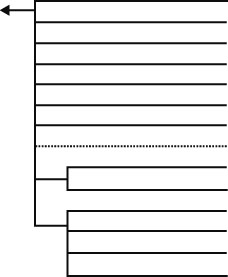| NIES-MCC | KU-MACC | Tree to Strain | Japanese | English |
| Life / Eukarya / Plantae / Viridiplantae / Chlorophyta / Ulvophyceae / Ulotrichales | |

|
Ulothrix Gayreria Chamaetricon Trichosarcina Hazenia Gloeotilipsis Helichodictyon "Pseudendoclonium" akinetum, "P". basiliense Pseudendocloniopsis Planophila Monostroma (sensu stricto)) "Gomontia" Eugomontia Collinsiella |
| * Dotted lines indicate they may be polyphyletic | |
| Reference |
|
|
Microscopic filamentous to macoscopic foliose ulvophycean algae. Many ulotrichalean algae inhabit in marine or freshwater, but trrestrial species are also known. The chloroplast and mitochondrial genome sequences are reported for "Pseudendoclonium" akinetum (Pombert et al. 2005, Mol. Biol. Evol. 22:1903-1918, Pombert et al. 2004, Mol. Biol. Evol. 21: 922-935). Organization is vaied, from sarcinoid, palmelloid, filamentous to foliose. Basically, gametes are biflagellate and zoospores are quadriflagellate. The terminal cap of the basal body is small. In the species for which sexual reproduction is known, vegetative thallus is a gametophyte and zygote is a only diploid stage which is sometimes reffered as a sporophyte. |